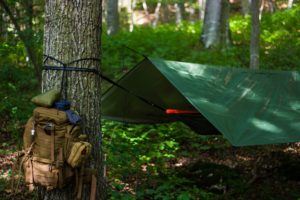While camping is an excellent way to create lasting memories with friends and family, many people are turned off by the thought of lacking a proper shower. Not all camping sites have public bathing facilities, and when they do, they can be uncomfortable, low-capacity, or even unsanitary.
So how do you shower while camping? If you do not mind a little set-up, the best way to shower while camping is to use a camping or backpacking shower. Lightweight, compact, and portable, camping showers are the perfect way to enjoy a little hygiene away from the comforts of home.
With some help, you can enjoy the great outdoors without basking in the dirt and grime that comes with it. Here is everything you need to know about camping showers and staying clean while exploring the wilderness.
What Are Camping Showers?

After a gross and sweaty day in the woods, a camping shower can seem like nothing short of a miracle. In their simplest form, camping showers consist of a showerhead, tubing, and a water reservoir. However, showers exist in a whole range of complexity, from simple containers with heads to solar-heated water. Camping showers often offer a variety of features such as:
- Heated water
- Water pressure
- Capacity
- Portability
You can purchase a camping shower for as cheap as $15 or splurge for some luxury. The most complex camping showers can cost up to hundreds of dollars. Check out Amazon’s Best Seller list to find a camping shower within your budget that also suits your needs.
How Do Camping Showers Work?
There are several types of camping showers, including gravity showers, solar showers, water-heater showers, and vehicle-mounted showers.
Gravity showers are simple and usually consist of hanging a showerhead in an advantageous position that allows water held in a reservoir to fall on your head.
Solar-powered camp showers are a straight-forward way to enjoy warm water showers. They use energy from the sun as a heating source for a water bag covered in a heat-absorbent material. Some tips for heating your solar-powered water bag include:
- Some bags only have one side of absorbent material. Make sure that side is sun up!
- Heat your bag at the beginning of the afternoon when the sun is at its hottest point.
- Depending on the weather, your water can take two to five hours to heat up. Purchasing a shower with a temperature gauge can be helpful to know when your water is ready.
Camping showers with a battery-powered pump are like solar-powered showers but tend to have a stronger flow and heat up more quickly. They generally contain conveniently rechargeable batteries.
Vehicle-mounted showers pump water from a nearby body of water, through a heat exchanger attached to your car’s engine, and into a water hose. They can be either propane gas or battery powered. The obvious downside is that they require a body of water and tend to come with a lot of equipment.
Compared to backpack showers, vehicle-mounted showers are heavy and lack mobility. Since they require replacement batteries or gas, they can be more expensive to upkeep. On the other hand, they are durable and heat water quickly while providing better water pressure.
If possible, set up your camping shower on a rocky surface, as plain dirt will quickly become mud, giving you more to clean off. Grass or leaf-cover are also better alternatives to uncovered soil.
What About Privacy?
If you value your privacy, consider setting up a shower shelter around your camping shower. Similar to a tent, shower shelters consist of four walls of polyurethane fabric mounted on fiberglass poles. They tend to vary in terms of amenities and extra features such as:
- Ceilings
- Floors
- Bars for hanging towels and clothes
- Pouches for holding soap and toiletries
You can purchase one on Amazon for anywhere from $23 to $125. If you are looking to save money, you can construct a makeshift shower quickly with a tarp, poles or sticks, and rope.
Do You Need to Shower While Camping?

While you may not need to shower while camping, it can certainly make your experience more enjoyable. Camping usually comes with strenuous activities such as hunting and hiking, and accumulated sweat can be sticky and uncomfortable. And if you are camping with others, you probably do not want to subject them to your odor.
More importantly, cleanliness can be vital for your health, as you will be exposed to all kinds of bacteria while out in the wilderness.
Alternatives to Showering
There are other ways to maintain your hygiene if you do not have access to a camping shower. Back-up solutions include:
- If you happen to be camping near a body of water, jump right in and enjoy a swim. With a washcloth, you can safely freshen up while enjoying a bit of nature. Keep in mind that soaps, even biodegradable ones, can have a detrimental effect on water and marine life. It is recommended that you use them no closer than 200 feet from a natural water source.
- A sponge bath can be a quick way to enjoy some warm water. Simply fill up a pot with water and heat it over a firepit. With some soap and a sponge or towel, you can wipe down for a full-body refresher.
- If you are without access to water or if it is simply too cold to take a full shower, baby or bio-wipes (Amazon) can be an easy alternative to remove some of the dirt from your skin. They can also double-down as toilet paper when nature calls.
- Dry shampoo is a powder substance that you can apply to your hair to eliminate and absorb the natural oil that makes it look greasy. While it does not actually clean your hair, it will make it look decent and save you some time. If you do not have access to dry shampoo, cornstarch can be used for a similar effect.
Though these methods may be less effective than a camping shower, they are better than nothing and will do in a pinch.
Tips for Maintaining Personal Hygiene While Camping

Beyond showering, there are strategies you can use to preserve a passable state of cleanliness. Here are some ways you can keep yourself clean outside of showering:
- When soap and water are inconvenient, hand sanitizer (Amazon) is an excellent alternative for keeping germs at bay.
- Though you may be tempted to bring deodorant for its fresh scent, it has the unfortunate tendency to attract bugs and other wildlife—even bears. Leave it at home and learn to love your natural odor.
- Changing and washing your clothes is an essential part of decent hygiene while camping. Bring at least two outfits so you can alternate between a set for wearing and one for cleaning.
- Avoid cotton materials as it absorbs and retains sweat while quickly getting dirty and causing uncomfortable chafing. Synthetic, moisture-wicking materials are optimal for handling moisture and limiting bacteria growth.
- Use a sleeping bag liner (Amazon) to keep your sleeping bag clean. It also makes it easier to wash.
- Dr. Bronner’s is a multi-purpose soap that can function as a shampoo, body wash, toothpaste, laundry detergent, and more. As a body soap, it can be used without water and simply rubbed off with a towel.
One important factor to consider in personal hygiene is the type of toilet you bring camping with you. Check out this post to learn more about the best portable camping toilets.
Final Thoughts
Camping is a fantastic way to disconnect from modern society and reconnect with the Earth, and camping showers are a simple solution for enjoying the great outdoors without becoming a part of it.






